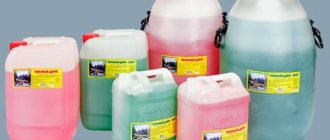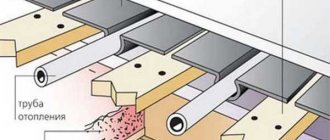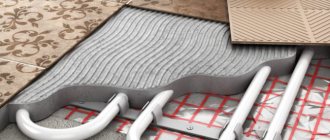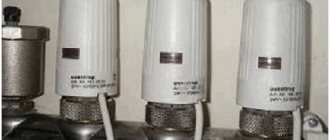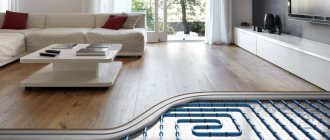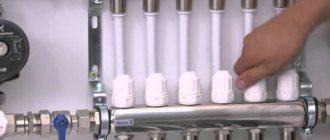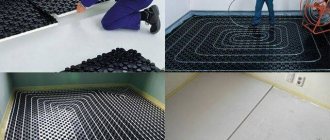Other articles on this topic:
⇒ Dry heated floor in a wooden house
A heating system with heated floors in a private house has the following features, advantages and disadvantages:
- provides increased thermal comfort due to optimal temperature distribution along the height of the room and heating of the floor surface with which a person is in direct contact;
- reduces fuel consumption without reducing thermal comfort;
- creates a hypo-allergenic atmosphere in the premises, thanks to the low temperature of heated floor surfaces;
- is an ideal heating device for modern heat sources - ensures operation with maximum efficiency of a condensing boiler or heat pump due to the low temperature of the coolant;
- does not distort the aesthetics of the premises , since it is hidden in the structures of the house and is invisible;
- slows down temperature fluctuations in the room , thanks to the large thermal inertia of the concrete screed - a heat accumulator, which increases comfort, optimizes and stabilizes the operation of the boiler, especially solid fuel ones.
- does not allow you to quickly change the temperature in the room due to high thermal inertia. This circumstance may become an obstacle to the use of heated floors in a private home without permanent residence;
- requires high-quality installation and construction work; correction of defects will require serious expenses;
- can create difficulties in decorating the interior of floors - not all materials are suitable as a heated floor covering, heat-emitting surfaces should not be covered with large furniture or a thick carpet - heat transfer will decrease.
- has a rather low maximum specific thermal power delivered to the room. Because of this, in some cases, the installation of additional heating radiators is required.
- requires the mandatory use of circulation pumps and electronic regulators to control the operating mode. When there is a power outage, the operation of the system is disrupted.
- creates additional load on the floor.
- the cost of a heating system with heated floors is noticeably higher than with radiators.
Warm floor in a private house
Maximum floor temperature
| Warm water floor in a private house. The thickness of the vertical thermal insulation between the wall and the screed should be the same as the horizontal one. |
The maximum floor surface temperature is limited to 29 °C. Higher temperatures are harmful to health. It is recommended that in areas where people are constantly occupied, the floor temperature should not exceed 26 °C. Along exterior walls and near windows, the floor can be heated to 33°C to compensate for increased heat loss in these areas.
The same floor temperature can be maintained in the bathroom, where people stay for a short time, and often without shoes. Due to the limitation of floor surface temperature, the maximum specific power of the underfloor heating system is 80 W/m2.
Maximum power of underfloor heating in a private house
A power of 80 W/m2 may not be enough for rooms with high heat loss, for example, with very large windows.
Problems can also arise in a small room, for example, in a cramped bathroom, in which, after installing a bathtub or shower stall, or other sanitary fixtures, only a small section of the floor remains where a heated floor system can be installed.
The same can be true in small bedrooms, where the large bed and wardrobes cover a significant portion of the floor, thereby reducing the efficiency of the underfloor heating system.
For example, a heated floor with an area of 10 m2 can produce a power of 800 W. The same power is provided by a panel radiator measuring only 50 x 50 x 15 cm due to the fact that its temperature is significantly higher than the floor temperature (in practice 70-80 ° C).
For each room of a private house, you can choose a radiator of the required power, but it is not always possible to heat any room in the house using a heated floor.
Strength of floors of a private house
The use of underfloor heating systems may be limited due to the creation of additional load on the floor, since the system pipes must be laid in a fairly thick layer of heavy concrete screed.
When deciding to install heated floors in a private home, you need to make sure that the load on the floor from the weight of the screed will not be excessive.
Please note that the thickness of the heated floor can significantly reduce the height of the room.
Warm floors will provide comfort and health.
The temperature distribution over height, closest to ideal, is provided by a heated floor system, Fig. 1.
Thermal comfort conditions
- that is, a state in which we are neither cold nor hot - are observed if the temperature of the heating surface does not exceed the temperature of our skin too much, and the air temperature does not differ much from the average temperature of the surfaces surrounding us - walls, floors and ceilings.
This is only possible when using low-temperature surface heating, in this case underfloor heating. In addition, the floor has a very large influence on the feeling of thermal comfort,
since this is the only enclosing surface with which we come into direct contact - through the soles of our feet, which are very sensitive to temperature.
It is especially advisable to use a heated floor system if the floor covering will be a material with a high thermal conductivity coefficient, for example, stone or tile, which seems cold to the touch.
Hypno-allergenic heated floor
An important advantage of the underfloor heating system is the absence of dust burning,
due to the lower temperature of the heating surface. At temperatures above 55 ° C (the surface of the radiator usually has a higher temperature), the process of dry distillation of organic dust particles begins, which, rising up with warm air, irritate the mucous membranes of the respiratory tract, causing a feeling of dryness in the throat.
Allergic reactions to dust depend not so much on the number of inhaled particles, but on their type - when heated to a temperature of more than 55 ° C, they increase in volume and irritate the mucous membranes even more. Therefore, low-temperature heating, such as underfloor heating, unlike traditional radiator heating, practically does not cause allergic reactions.
Do you need a heated floor in a private home - a source of comfort and health? The answer, I think, is obvious.
Wise choice of materials
For ease of classification, all materials for water heated floors should be divided into “accessible” and “closed”. The second one is a pipe. It will be immured in a screed, which increases the requirements for its reliability.
#1. Pipe selection
Basic requirements for a pipe for water underfloor heating:
- One circuit - one pipe.
- Joints and seams are unacceptable.
- The maximum pipe length in the circuit is 100 m.
Almost all water floors are assembled from pipes with a diameter of 16 to 25 mm. Based on material, they are divided into metal and polymer-composite.
Metal pipes
There are only two options in this category: copper and corrugated stainless steel.
Copper pipes for water heated floors are an ideal option in almost all respects. Only their cost and the complexity of installation work cover the advantage of using them.
Corrugated stainless steel is a relatively new material, but with powerful potential and good recommendations. These pipes are also more expensive than their polymer counterparts, but the rupture is not catastrophic.
Properties common to metal pipes:
- high thermal conductivity;
- immunity to overheating;
- resistance to high pressure;
- electrical conductivity.
Polymer composite pipes
Purely polymer pipes are polypropylene and cross-linked polyethylene (can be reinforced), and composite pipes are metal-plastic.
They work well in standard operating mode, but are afraid of prolonged overheating at elevated pressure. In an underfloor heating circuit, the operating mode for polymer pipes is optimal - the coolant temperature is much lower than the limit values.
#2. Choice of insulation
Rigid polymer foams are almost always preferred. Mineral wool thermal insulators have comparatively low thermal conductivity, but they are susceptible to dampness and tend to caking.
There is also a choice among polystyrene foams, but in practice, specialized heat insulators made from extruded polystyrene foam are almost always used. They can be produced in the form of smooth slabs or mats with bosses. In the first case, the pipe is fixed with mounting anchors or brackets, and in the second it is pressed between the protruding stumps of the bosses.
The pipe is held very firmly. The heat insulation sheets must be fixed to the base and the joints taped.
A damper tape is laid around the perimeter of the room. In addition to compensating for the thermal expansion of the screed, it also acts as a heat insulator.
#3. Other components and manifold
The manifold regulates the flow of coolant into the circuit. This is a whole conglomerate of parts and devices designed to connect several circuits.
Each circuit is controlled independently: the thermostat receives data from temperature sensors or an external control unit, and then changes the clearance in the pipe through a servo drive.
In general, the collector can have different designs: brass, stainless steel or polymer. But plastic ones are not in demand.
The flow meter included in the collector serves to equalize the coolant flow in circuits of different lengths. The setup is complicated, but one-time.
A three- or two-way valve is connected to the system before the manifold to mix hot and cooled water.
The pump can only be a circulation pump. The defining parameters are flow and pressure.
Circular pump
The flow rate is calculated using the formula: V = 0.86 * W/TΔ, where W is the installed thermal power, and TΔ is the difference in supply and return temperatures. For example, a cottage requires 20 kW of thermal power, set TΔ to 5˚C, we get (0.86 × 20)/5 = 3.44 m3/h. If we increase TΔ to 10˚C, then (0.86 × 20)/10 = 1.72 m3/h.
The pressure is calculated using a more complex formula, because on the equipment this parameter is indicated in “vertical column meters”, and the system operates with a pipeline located in a horizontal projection.
#4. Boiler selection
Basic parameters of the boiler: power and type of fuel. For individual houses there is an average rule when choosing a boiler - 0.1 kW/m2. Those. for a cottage of 200 m2 you will need a boiler with a capacity of 20 kW.
But as the quality of the house’s thermal insulation improves, the boiler power may be reduced.
Professional design of a water heated floor is more profitable because it allows you to more accurately select a boiler based on performance, avoiding cost overruns. After all, the heat loss of an object with the specific characteristics of the enclosing structures will be calculated.
The type of fuel affects automation and efficiency. Absolute controllability is only achievable in electric boilers. But electricity is the most expensive energy carrier. It is most profitable to heat with gas.
Even solid fuel boilers (pellet boilers) are subject to automation.
The most profitable boilers for underfloor water heating are low-temperature or condensing. They have two advantages:
- They remove heat from combustion gases through a second heat exchanger.
- The maximum outlet water temperature is 60.
The efficiency of condensing boilers exceeds 100%.
#5. Poor quality materials and possible consequences
Nobody wants to buy low-quality goods, but everyone wants to save money. This is what can lead to tragedy. Failure of the safety group in the water heated floor system in a certain combination with other factors can result in a boiler explosion and fire.
Cheap metal-plastic pipes purchased from an unknown supplier can be successfully laid into a circuit, then checked by crimping. But after they are filled with screed and put into operation, they may leak or even burst. This is not a fire, but major repairs are guaranteed.
The collector can be assembled with your own hands from components from different manufacturers. It can work very well for a year, two or three. But the guarantee that it will function at all is given not by the manufacturer, but by the assembler of the device.
Branded equipment can also break down and fail. But this happens in exceptional cases, and, depending on the type of warranty, the company compensates for the costs of repairing and restoring the system.
Warm floors in a private house save thermal energy
Comfortable room temperature with heated floors is 2 °C lower than with radiator heating.
This reduction in temperature can save up to 5% of thermal energy for heating. This is due to the phenomenon of our body radiating heat towards cold surfaces - in this case, the floor.
If the floor is warmer, less heat from our body is radiated in its direction,
therefore, the required comfortable thermal balance is achieved at a lower indoor air temperature. This is the most important advantage of surface heating.
The possibility of a slight decrease in room temperature without loss of comfort is also affected by the temperature distribution over altitude.
If your feet are warm, the room temperature can be slightly lower without any discomfort.
Which is better?
When choosing a heated floor for your home made from SIP panels, you should focus on your financial capabilities, and also, of course, trust the installation only to professionals. As mentioned above, improper installation of, for example, a water heating system can entail even greater costs and a large number of troubles.
On our website you can look at projects of SIP houses and use their layouts to immediately decide where exactly the floor will warm your feet.
Warm floor - heat accumulator
A warm floor takes several times longer to heat up than radiators - before the heat begins to be transferred into the room, the concrete slab in which the coolant pipes are located must heat up. A heated concrete slab will release heat after a long time
after shutting off the flow of coolant into the system.
The ability of a heated floor to act as a heat accumulator, slow down the processes of temperature changes in the room, optimizes and stabilizes the operating mode of a heating boiler, especially a solid fuel one. more about this here.
At the same time, a heated floor is more difficult to adapt to rapidly changing heat needs when the outside temperature changes sharply. This can lead to overheating of the premises, that is, unnecessary heat loss. Or vice versa, to underheating and reduced thermal comfort.
High thermal inertia
also makes it difficult to periodically lower the temperature while the occupants are away.
Household products
⇆
Automatic control of heated floors in a private house
Automatic control of the heating system is necessary to maintain a comfortable temperature in the premises, as well as to optimize energy consumption.
The lack of control can lead to overheating of rooms and increased heat consumption.
The figure below shows the control circuit diagram
mixed heating system for a private house - using heated floors and radiators.
To control the radiator system, the automation that the boiler is equipped with, supplemented by thermostatic valves installed on the radiators, is sufficient. Connecting a heated floor circuit to the heating system requires the use of additional devices that reduce the temperature of the coolant entering the system - a mixing pump and a three-way mixing valve.
Warm floors with weather controller
Considering that the underfloor heating system has a high inertia (it heats up slowly and cools down slowly), it is recommended to use weather automation to control its operation.
Then the temperature of the coolant supplied to the system will be adapted to the outside temperature. Due to this, along with changes in outside temperature, the temperature of the coolant circulating in the floor changes.
When adjusted using a room thermostat, the temperature of the coolant in the system will not change until it begins to rise in the room (due to warming outside). Only after this the temperature of the coolant will begin to decrease, but due to the inertia of the system, the room will already become hot (i.e., waste of energy).
Therefore, in order for home heating to be economical, a weather controller must be used in the underfloor heating system to control it.
When heating with radiators, satisfactory results can be achieved using cheaper thermostats.
Battery connection methods
Batteries can be installed in a structure such as a single-pipe heating system for a two-story house (a photo of such equipment is clearly demonstrated on the page) using any of the currently available technologies. The connection diagram is:
- Lower. In this case, the “supply” and “return” pipes are connected to the battery from below.
- Diagonal. With this scheme, the pipes are connected to the radiator from above and below from opposite sides.
- Vertical. In this case, the main line is connected at the top and bottom on one side.
To ensure that the air in both the rooms farthest and those closest to the boiler is heated evenly, radiators are usually connected to the pipe bypass. This creates a simplified analogue of a two-pipe system. With a bypass, it is easy to regulate the volume of flow passing through the radiator.
Aesthetics of heated floors in a private house
The heating system, first of all, must provide thermal comfort, as well as function smoothly, and it is very desirable that it does not disturb the residents.
One of the advantages of underfloor heating systems is that they are invisible.
In a heated floor system, the heating elements are pipes that are laid in the floor and do not interfere with the finishing of the premises.
Certain restrictions apply only to the choice of flooring,
since not all of them are suitable for use in conjunction with underfloor heating systems. Some are not intended for use at elevated temperatures - they emit harmful substances, become deformed, crack, and lose their appearance; others are good thermal insulation, making it difficult to heat rooms.
It is best to use materials with a high thermal conductivity coefficient for finishing the floor - stone or ceramics.
These are the most suitable materials for heated floors; the others make it more difficult to transfer heat into the room.
But this does not mean that carpet, laminate or wood panels cannot be used as flooring. You just need to follow the recommendations regarding their installation on a floor with a heated floor system.
For example, laminate and linoleum must have special markings indicating that it can be laid on heated floors. It is recommended to use wood coverings with a thickness of no more than 2 cm.
The only visible element of the underfloor heating system is the distribution cabinet, which contains the control valves for the individual heating loops. Typically, one closet is installed per floor of the house, which is placed in an inconspicuous place - in the hallway, wardrobe or utility room.
Installation procedure
A one-pipe system is assembled as follows:
- In the utility room, the boiler is installed on the floor or hung on the wall. Using gas equipment, the most reliable and efficient single-pipe heating system for a two-story house can be installed. The connection diagram in this case will be standard and will allow you to carry out all the work, if desired, even independently.
- Heating radiators are hung on the walls.
- At the next stage, the “supply” and “return” risers are installed on the second floor. They are located in close proximity to the boiler. At the bottom, the outline of the first floor is connected to the risers, and at the top – to the second.
- Next, the connection to the battery lines is made. A shut-off valve (on the bypass supply section) and a Mayevsky valve should be installed on each radiator.
- An expansion tank is mounted in the immediate vicinity of the boiler on the “return” pipe.
- Also, on the “return” pipe near the boiler, a circulation pump is connected to a bypass with three taps. A special filter is installed in front of it on the bypass.
At the final stage, the system is pressure tested in order to identify equipment malfunctions and leaks.
As you can see, a single-pipe heating system for a two-story house, the design of which is as simple as possible, can be a very convenient and practical equipment
However, if you want to use such a simple design, at the first stage it is important to make all the necessary calculations with maximum accuracy
13 signs that you have the best husband Husbands are truly great people. What a pity that good spouses don't grow on trees. If your significant other does these 13 things, then you can s.
11 Weird Signs That You're Good in Bed Do you also want to believe that you please your romantic partner in bed? At least you don't want to blush and apologize.
How to look younger: the best haircuts for those over 30, 40, 50, 60 Girls in their 20s don’t worry about the shape and length of their hair. It seems that youth is created for experiments with appearance and daring curls. However, already last.
What is it like to be a virgin at 30? I wonder what it’s like for women who didn’t have sex until almost middle age.
Why do you need a tiny pocket on jeans? Everyone knows that there is a tiny pocket on jeans, but few have thought about why it might be needed. Interestingly, it was originally a place for storage.
Never do this in church! If you are not sure whether you are behaving correctly in church or not, then you are probably not acting as you should. Here's a list of terrible ones.
Do you need heated floors in a private home?
Warm floors are a fairly expensive system and you can do without it, but the comfort created is worth spending money on its installation.
What to choose? Is it worth paying more to get something better? It depends on how strong the desire is and how much you need to pay extra.
The cost is determined by the need to lay a thicker layer of thermal insulation, a thicker layer of screed, and use a more complex control system. During its execution, there is a greater likelihood of making errors, and correcting them and eliminating the consequences of a possible accident is usually a more expensive process.
When installing floors on the ground in a house, a warm floor in a private house is the best solution - the additional costs will be relatively small and justified by the increased thermal comfort.
In the case of heating a house with a solid fuel boiler, it is advisable to use a heated floor as a heat accumulator.
Experience in operating heated floors shows that the system is very reliable and problems rarely arise with it. It has been sufficiently mastered, and its installation should not cause difficulties for specialists. Higher cost and a higher risk of something going wrong is the price you have to pay to enjoy the comfort provided by underfloor heating.
The most universal is the frequently used solution with a mixed system,
in which some of the rooms (for example, bedrooms) are heated by radiators, and the rest - where the flooring is ceramic or stone tiles (living room, kitchen, bathrooms, toilets) - by a heated floor system.
Do you need heated floors in a private home? – I hope that this article will help you make the right decision.
Do you need heated floors in a private home? Vote!
Find out what others have chosen.
Look!
— all polls
More articles on this topic:
⇒ Dry heated floor in a wooden house
More articles on this topic
- Frame house with communications - features and advantages
- Radon indoors. Protecting your home from radon
- Solar collector - water heater for home, pool
- Interior decoration of house walls made of aerated concrete, gas silicate
- Review of heating equipment "Teplodar"
- Concrete floor on the ground in a stone private house
- Cesspool storage septic tank for sewage pumping
- What is good about aerated concrete? Pros and cons of aerated concrete - gas silicate
Kinds
Mats for water heated floors vary in function and quality, design and production method.
Foil products.
Foil foam is the main component of these mats. Mats with foil are used in heated rooms as an additional heat source. The pipes are placed on the side covered with foil. To do this, you need to purchase additional fasteners.
Mats with bosses.
On the surface of such products there are shaped protrusions (bobs). The production of mats with bosses is based on hydropellet stamping.
Mats for water heated floors with film.
The products consist of three layers - polystyrene foam, foil and film. The density of such a mat is 30-35 kg per cubic meter, which is enough for a water-heated floor. The advantage of this product is the markings, which facilitate the installation process.
Flat mats made of polystyrene foam.
The thickness of the material of such a mat is 50 mm, and the density is up to 40 kg per cubic meter. Thanks to this feature, the product is able to maintain its shape and size under external influences. Special plastic brackets are suitable as fasteners for a flat mat.
Before buying mats for water heated floors, you should check for certificates of conformity. Respectable manufacturers do not hide their product documents.
